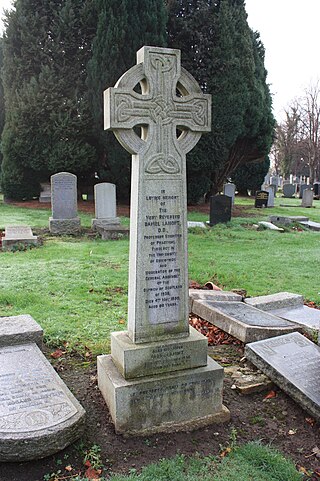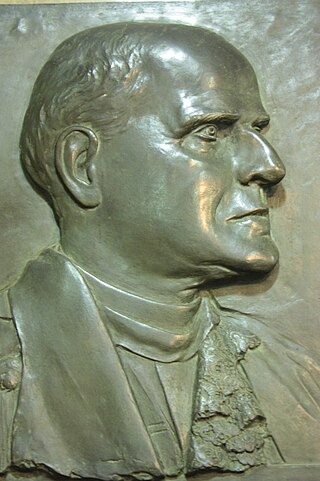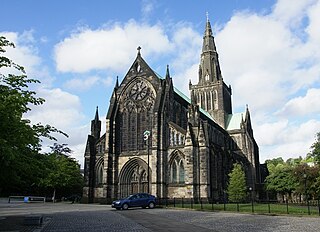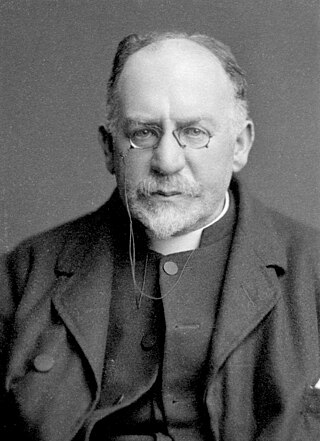

William Menzies Alexander (Shettleston, then in Lanarkshire, 12 May 1858 – Edinburgh 30 August 1929) was a Scottish medical and theological writer. [1] He was Moderator of the General Assembly for the Free Church of Scotland for 1911/12.


William Menzies Alexander (Shettleston, then in Lanarkshire, 12 May 1858 – Edinburgh 30 August 1929) was a Scottish medical and theological writer. [1] He was Moderator of the General Assembly for the Free Church of Scotland for 1911/12.
He was born in Shettleston on 12 May 1858, the son of John Alexander and his wife, Margaret Menzies. [2]
After graduating B.Sc. from the University of Glasgow in 1885 Alexander trained as a medical missionary and taught biology and chemistry at Wilson College in Bombay, before returning to Scotland to complete M.B. (1888), B.D. (1889) and M.D. (1891). He then returned to Bombay where he was examiner to the Technical College and the University of Bombay until he contracted an illness that permanently damaged his hearing. He returned to Scotland and was appointed Professor of the new Free Church College in 1904, teaching most subjects in the curriculum, including Hebrew. Later, he was moderator of the General Assembly in 1911. He obtained the degree of D.Sc. in 1919.
He died in Edinburgh on 30 August 1929. He is buried nearby his home, with his wife, Agnes Campbell (1852–1933), in Morningside Cemetery, Edinburgh. His unusual polished black stone stands on an east–west path near the centre of the cemetery, towards its western end.
Alexander is best remembered for his work Demonic Possession in the New Testament (1902), which attempted to explain accounts of demonic possession in the synoptic Gospels in medical and scientific terms. This caused a controversy in regard to his position as Professor of Divinity at Free Church College, Edinburgh, with accusations of non-belief in the inspiration of Scripture being made against Alexander and the College. [3] In fact, Alexander did retain belief in the miraculous, and considered that the affirmations of the possessed of the Messiah were the miraculous element, but that descriptions of the illness were simply largely the language of the day. In an address in Edinburgh in 1910 entitled "The Origin and Antiquity of Man in the light of Evolution and Scripture", Alexander laid out his reasoning for affirming special creation and rejecting what he described as the "theory of a descent of man from apes". [4]
He married Agnes Campbell Blair (1857-1933) on 18 September 1889 in Glasgow, Scotland.
They lived at 11 St Ninians Terrace in south-west Morningside. [5]
The United Presbyterian Church (1847–1900) was a Scottish Presbyterian denomination. It was formed in 1847 by the union of the United Secession Church and the Relief Church, and in 1900 merged with the Free Church of Scotland to form the United Free Church of Scotland, which in turn united with the Church of Scotland in 1929. For most of its existence the United Presbyterian Church was the third largest Presbyterian Church in Scotland, and stood on the liberal wing of Scots Presbyterianism. The Church's name was often abbreviated to the initials U.P.

Sir George Adam Smith was a Scottish theologian. He was the Principal of the University of Aberdeen between 1909 and 1935 and an important figure in the United Free Church of Scotland.

Hugh Ross Mackintosh was a Scottish theologian, and parish minister who served as Moderator of the General Assembly of the Church of Scotland in 1932.
The Free Church of Scotland is a conservative evangelical Calvinist denomination in Scotland. It is the continuation of the original Free Church of Scotland that remained outside the union with the United Presbyterian Church of Scotland in 1900, and remains a distinct Presbyterian denomination in Scotland.

The Grange is an affluent suburb of Edinburgh, just south of the city centre, with Morningside and Greenhill to the west, Newington to the east, The Meadows park and Marchmont to the north, and Blackford Hill to the south. It is a conservation area characterised by large early Victorian stone-built villas and mansions, often with very large gardens. The Grange was built mainly between 1830 and 1890, and the area represented the idealisation of country living within an urban setting.

Daniel Lamont (1870-1950) was a Church of Scotland Minister and academic. He was a Professor of Theology at New College, Edinburgh from 1927 to 1945; and Moderator of the General Assembly of the Church of Scotland from 1936 to 1937.

John White CH (1867–1951) was a minister of the Church of Scotland. He served as Moderator of the General Assembly of the Church of Scotland in 1925 and again at the reunion Assembly of 1929. White was one of the most influential figures in the Church of Scotland during the early decades of the 20th century, though his influence waned later in his life and he appeared increasingly isolated and anachronistic.
David Bruce DD was a Scots-born New Zealand Presbyterian minister and journalist who spent his final years in Australia.

David Brown was a son of bookseller who was twice Provost of the city. He was a Free Church of Scotland minister who served as Moderator of the General Assembly 1885/86. He was co-author of the Jamieson-Fausset-Brown Commentary on the whole Bible.

Archibald Campbell Douglas was a Scottish architect based primarily in Glasgow. He designed many churches in Glasgow and Edinburgh, especially those for the Free Church of Scotland.

Morningside Cemetery is a cemetery in south Edinburgh. It was established in 1878 by the Metropolitan Cemetery Company, originally just outwith the then city boundary, the nearest suburb then being Morningside. It extends to just over 13 acres in area. The cemetery contains 81 war graves. Although arguably visually uninspiring the cemetery contains the graves of several important female figures; including a female air commandant, Scotland's first female surgeon, the first female Fellow of the Royal College of Physicians of Edinburgh, and many church missionaries. Sir Edward Victor Appleton GBEKCB FRS who was an English physicist, Nobel Prize winner (1947) and pioneer in radiophysics is also buried here.

Sir Alexander Russell Simpson FRCPE FRSE LLD was a Scottish physician and Professor of Midwifery at the University of Edinburgh. He invented the axis-traction forceps also known as the obstetrics forceps which assisted in childbirth and reducing pain.

William Muir FRSE (1787–1869) was a Scottish minister of the Church of Scotland. He served as Moderator of the General Assembly of the Church of Scotland in 1838.

Pearson McAdam Muir (1846–1924) was the minister of Glasgow Cathedral and Moderator of the General Assembly of the Church of Scotland in 1910. He served as Grand Chaplain of the Grand Lodge of Freemasons of Scotland. He was Chaplain in Ordinary in Scotland to King Edward VII.d

George Milligan DCL DD was a Scottish minister of the Church of Scotland who served as Moderator of the General Assembly of the Church of Scotland in 1923. He was professor of divinity and biblical criticism at the University of Glasgow.
John Kennedy Cameron was a minister of the Free Church of Scotland who served as Moderator of the General Assembly in 1910/11.
Alexander William Mair was a 20th century Scottish scholar who was a professor of Greek at the University of Edinburgh. He was an authority on the works of the Greek poet Hesiod.

Alexander Mair (1834–1911) was a Scottish minister of the United Presbyterian Church who served as its final Moderator in 1899/1900.
Alexander Martin was a Scottish minister, successively of the Free Church of Scotland (1843–1900), the United Free Church of Scotland and the Church of Scotland. He was Principal of New College, Edinburgh 1918-1935 and one of the architects of the union of the United Free Church of Scotland and the Church of Scotland in 1929.
Alexander, William Menzies. Demonic Possession in the New Testament. ISBN 9780766147072.